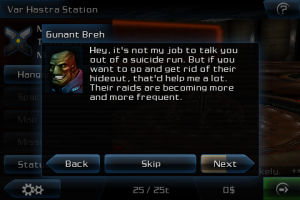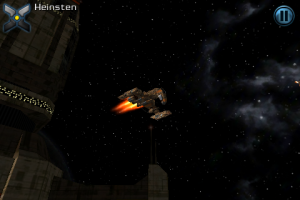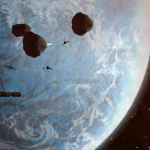 Combat missions are still the most satisfying items on Keith’s agenda, and while I found targeting forgiving enough to make the game accessible to a wide audience, there’s no question that previous experience with flight sims will be a boon to the player’s experience here. Optional and highly lucrative combat sidequests can get especially rough, but luckily Keith has a number of options at his disposal for tackling a given situation. Flight sim veterans will be tempted to take on well-armed enemies for the sheer thrill and bragging rights – the game awards medals for things like docking with a heavily damaged ship – but most will want to play it safe and splurge on homing missiles or hire backup mercenaries in space lounges. The game autosaves every time the player docks, so lunging into an enemy armada never threatens to set the player back unduly.
Combat missions are still the most satisfying items on Keith’s agenda, and while I found targeting forgiving enough to make the game accessible to a wide audience, there’s no question that previous experience with flight sims will be a boon to the player’s experience here. Optional and highly lucrative combat sidequests can get especially rough, but luckily Keith has a number of options at his disposal for tackling a given situation. Flight sim veterans will be tempted to take on well-armed enemies for the sheer thrill and bragging rights – the game awards medals for things like docking with a heavily damaged ship – but most will want to play it safe and splurge on homing missiles or hire backup mercenaries in space lounges. The game autosaves every time the player docks, so lunging into an enemy armada never threatens to set the player back unduly.
One thing Galaxy on Fire 2 could do to improve in future updates is to allow the player to assume multiple sidequests at once, a tried-and-true convenience that Action RPGs have traditionally implemented to wonderful effect on this platform. Keith can dump an optional mission at any time if a more lucrative opportunity arises, but the player’s inability to mass-collect tasks weighs on the player’s experience a bit early on. This is because he’ll often have to travel to star systems that are distant from the sidequest-originating NPC’s space station, and until a certain item can be purchased this requires the player to leapfrog one system at a time manually, which becomes a bit of a chore at times. At least Keith doesn’t usually have to make the reverse trek back — his monetary reward is conveniently credited to him at a distance more often than not.
 Finding one’s way around the universe Fish Labs has built for Galaxy on Fire 2 is a wonderfully smooth process at any rate. Description logs for both story and side missions skimp on navigational detail in favor of further scenario-building at times, which will suit the player just fine once he or she gets a look at Keith’s star map and finds the appropriate destinations clearly marked. Also labeled are each star system’s factional allegiance and “security” level, which will clue the player in to whether or not Keith should be packing extra firepower before heading into a given location.
Finding one’s way around the universe Fish Labs has built for Galaxy on Fire 2 is a wonderfully smooth process at any rate. Description logs for both story and side missions skimp on navigational detail in favor of further scenario-building at times, which will suit the player just fine once he or she gets a look at Keith’s star map and finds the appropriate destinations clearly marked. Also labeled are each star system’s factional allegiance and “security” level, which will clue the player in to whether or not Keith should be packing extra firepower before heading into a given location.
Also well executed is the user interface, although the player might not agree at first because the game doesn’t put its best foot forward at the outset. Keith begins the game with a fully featured fighter craft packing secondary weapons, a thruster capable of speed boosts, an accurate sensor array, and other bells and whistles. Just when the player has begun acclimating to the various virtual buttons the starting ship’s equipment enables, the plot requires that Keith begrudgingly trade in his craft for a less fully featured mining ship on loan from an NPC. This, in turn, changes the virtual button layout a bit and extends the player’s learning curve.
 Thankfully, the player’s in for a very smooth ride once this period of acclimation is finally settled. The virtual joystick suits just fine for maneuvering Keith’s ship and a very handy reverse-view button lets the player see what lies behind in cases where he’s taking fire from an unknown source or needs to make a second pass at floating items. I never did get a good handle on the tilt control scheme that can be used in place of the virtual joystick, however; I didn’t find it sensitive enough for the player’s needs, and in any case having to change the angle at which the player views the touchscreen seems less than conducive to keeping track of enemies during intense dogfights.
Thankfully, the player’s in for a very smooth ride once this period of acclimation is finally settled. The virtual joystick suits just fine for maneuvering Keith’s ship and a very handy reverse-view button lets the player see what lies behind in cases where he’s taking fire from an unknown source or needs to make a second pass at floating items. I never did get a good handle on the tilt control scheme that can be used in place of the virtual joystick, however; I didn’t find it sensitive enough for the player’s needs, and in any case having to change the angle at which the player views the touchscreen seems less than conducive to keeping track of enemies during intense dogfights.
Oh, did I mention that Galaxy on Fire 2 is jaw-droppingly gorgeous and runs silky smooth with the latest updates, even on second gen iDevices? Fish Labs respectably puts eye candy at a bit of a distance as Keith wakes up in one of the more empty parts of the galaxy at first, but a good hour in and the player will begin seeing stunning planetary vistas that make one wish Keith were a bit more of a landlubber — his travels focus on space stations orbiting celestial bodies, so the heavenly objects themselves are a strictly look-but-don’t-touch affair.
Pumping money into voice acting is probably the riskiest thing Fish Labs could have done in terms of presentation, but it’s clear they have access to some of the gaming industry’s best voice talent. Fully voiced conversations breathe extra life into already excellent writing, and even sidequests receive their fair share of acting talent. Galaxy on Fire 2‘s soundtrack may not quite stand on its own, but it’s creatively used for important gameplay cues. Serene ambience tells the player he or she can reach for a fast-forward virtual button to speed Keith’s travels along, whereas a blood-pumping tune means some lasers are about to be fired in his ship’s direction.
iFanzine Verdict: Galaxy on Fire 2 is one of that rare breed of games that can be recommended regardless of preferred genre. Not only are its production values and level of polish out of this world, but the game is completely engrossing on multiple levels and its open ended gameplay possibilities justify an extra trip or two through its impressive length. While it ranks among the more expensive games at the AppStore, rest assured that it’s absolutely worth the weight of its price tag.


